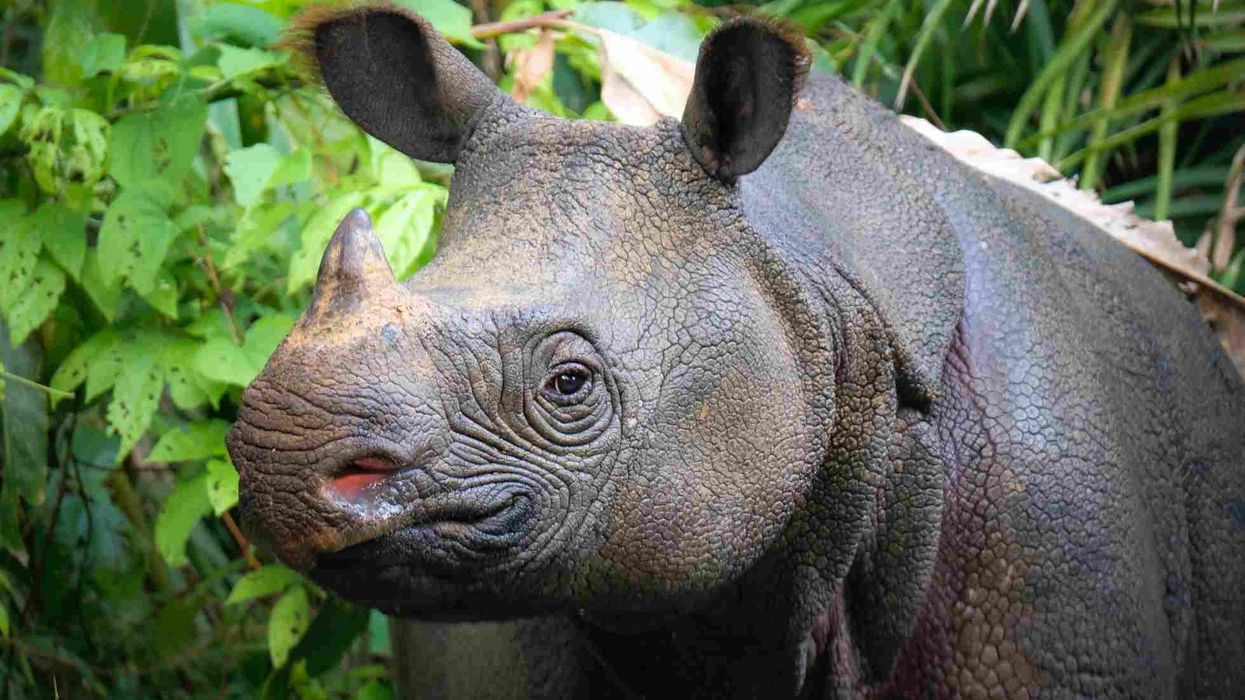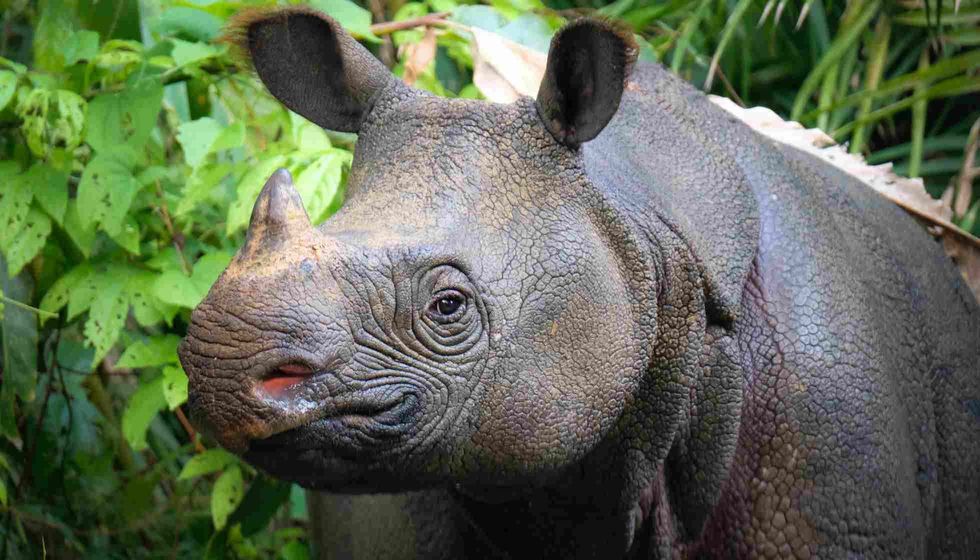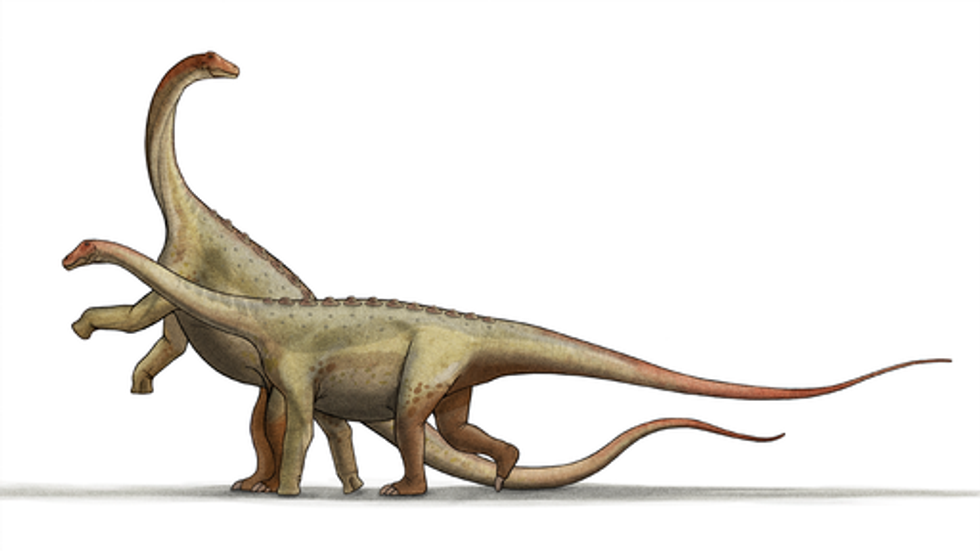Javan rhinos with the scientific name Rhinoceros sondaicus are the rarest of the five rhino species. The Javan rhino population once was the most widely spread amongst the Asian rhino but now is on the verge of extinction due to poaching. The population of these rhinos is now limited to the national park in Java, Indonesia.
The Javan rhino is one of the greater one-horned rhino species. This one-horned rhinoceros has a dark gray-colored loose skin with multiple folds, making it appear much like armor.
This rhino species is very close relative to the greater one-horned rhinoceros but has a significantly smaller head and less perceivable skin folds. The single horn possessed by this Javan rhino species is about 10 in (25.4 cm) long and the species are often hunted for this very horn.
The Javan rhinoceros horn is precious in the black market and costs around 60,000 USD for each kilogram. A single horn can be as valuable as 150,000 USD.
The horn of these wild animals is highly valued in traditional Chinese medicine. Due to their constant poaching for this reason and the loss of their natural habitat, the Javan rhinoceros population has declined to a mere 60, bringing the population down to a Critically Endangered status.
If you enjoyed our simplistic yet informational approach to decoding the mystery behind the Javan rhino, you could also check our articles on the masked palm civet and Siberian tiger.
Javan Rhinoceros Interesting Facts
What type of animal is a Javan rhinoceros?
The Javan rhinos are closely related animals to the family Rhinocerotidae.
What class of animal does a Javan rhinoceros belong to?
The Javan rhinos are mammals belonging to the phylum Chordata and the kingdom Animalia.
How many Javan rhinoceroses are there in the world?
The Javan rhino population is extremely vulnerable and these wild Asian animals are now only limited to the Ujung Kulon National Park of Indonesia. The Javan rhinos left around in the world according to the most reliable census is around 60.
Where does a Javan rhinoceros live?
The Javan rhinos prefer the natural habitat of low-lying areas and dense tropical rainforests with mud and water.
What is a Javan rhinoceros' habitat?
The Javan rhinos habitat now is only left to the Ujung Kulon National Park of Indonesia. These Javan rhinos were once widespread in Asia from Assam in India to Cambodia, Vietnam, and Java.
Who do Javan rhinoceroses live with?
All the shreds of evidence point out to these animals once having a convivial nature. But currently, these animals appear to be quite anti-social due to the natural disasters and the poaching this species has gone through.
The Javan rhinos can be found in small groups while wallowing. Breeding pairs and females with calves can also be observed. But other than these examples the Javan rhino prefers living in solitude.
How long does a Javan rhinoceros live?
Javan rhinos age in the wild is observed to be around 30 to 40 years of age. The other rhino species might live up to 50 years of age, so the Javan rhino lives a little shorter than other species.
How do they reproduce?
Javan rhino females reach the age of sexual maturity around three to four years of age which is much shorter than Javan Rhino males who mature around six years of age. The reproduction rate of Javan rhinos is very low, which contributed to the further decrease in this species' population.
Javan rhino calves take birth once every four to five years and are fed by their mothers for up to two years.
What is their conservation status?
The conservation status of Javan rhinos is in the Critically Endangered zone. The Javan rhino population is now completely extinct from the wild other than a few pieces of anecdotal evidence from places like Vietnam.
These animals currently are only present in the Ujung Kulon National Park in Java, Indonesia. Humans are the primary threats to the Javan rhino species. From poaching to trophy hunting and agriculture, humans slowly killed the Javan rhinos and destroyed their natural habitat.
Destroying the habitat led to them living in small artificial areas, which eventually caused disease, inbreeding, and depression in their limited population. From being widespread across Asia, today, there are as few as 60 Javan rhinos left around the globe.
Javan Rhinoceros Fun Facts
What do Javan rhinoceroses look like?
The Javan rhino is a dusky grey herbivore possessing just one horn. These rhinos are hairless with folds and crests on their skin, giving them the appearance of being wrapped in armor.
The male Javan rhino has clear visible horns that can be as big as 10 in (25 cm). The female rhinos of the species do not possess a horn or might have a very small one.
Indian Javan rhinoceros' became Extinct a long time ago but the closest species in terms of appearance to the Javan rhino are the Great Indian rhinos. Although the Javan rhinos are smaller and with less apparent skinfolds than their Indian counterparts.
*Please note that this is an image of a rhinoceros not a Javan rhinoceros. If you have an image of a Javan rhinoceros please let us know at hello@kidadl.com

How cute are they?
In the words of Oden Nash, "The Rhino is a homely beast, For the human eyes he's not a feast, But you and I will never know Why nature chose to make him so". The Javan rhino, as described beautifully, is an adorable homely beast.
Although we can't domesticate one of these wild beasts, they are one of the cutest in the Animal Kingdom for sure, often being called gentle giants.
How do they communicate?
Javan rhinos are silent creatures that do not communicate much. The recorded vocals of these rhinos are very few. However, they do communicate indirectly through urine, dung, and secretions of the foot glands.
How big is a Javan rhinoceros?
These rhinos are significantly smaller than most other rhinos. These beings are around 4.6-5.6 ft (1.4–1.7 m) tall. In comparison, they are about as tall as a zebra or gorilla.
How fast can a Javan rhinoceros move?
The Javan rhino can move around 30-40 miles per hour.
How much does a Javan rhinoceros weigh?
Javan rhinoceros' information available to us are limited and we can not find accurate measurements. But as far as the most reliable sources go the Javan rhino weighs somewhere between 1,98lb-5,070 lb (900 kg-2,300 kg).
What are the male and female names of the species?
The male Javan rhino is called a bull, while the female Javan rhino is called a calf.
What would you call a baby Javan rhinoceros?
Baby Javan rhinos are called calves.
What do they eat?
The preferred food of Javan rhinos is a wide variety of plants. The food of these rhinos includes leaves and twigs grown in unshaded locations in the forest. The Javan rhinoceros' diet is strictly herbivore and therefore mostly found in areas of vegetation or forest where the quantity of food available is abundant.
Are they dangerous?
Although this endangered population from Java, Indonesia has a herbivore food pattern they can get quite aggressive around humans. There have been anecdotally recorded pieces of evidence where the Java rhino population has engaged violently with the human population. The sheer amount of strength these beasts carry makes them quite dangerous for the human population.
Would they make a good pet?
The Javan rhino population is extremely small with only around 60 left. The population of this beast is only limited to the Ujung Kulon National Park of Indonesia.
This rarity not only makes them impossible to obtain and illegal to keep as a pet but these creatures with their sheer strength can be quite violent. They might physically harm you to an extent that could cause death and so they would not make a good pet.
Did you know...
The Arenga Palm, a unique palm tree, acts as an invasive species in the Ujung Kulon National Park of Indonesia with its ability to survive and thrive in very little sunlight. The Arenga Palm then forms an invasive canopy where other plants in the forest cannot grow, thus destroying 250 plants that the rhino usually feeds upon.
Serious measures are now being undertaken by the wildlife sanctuary to protect Javan rhinos from this invasive species of plants so that they can feed on what they usually do.
Is The Javan rhinoceros Endangered?
The Javan rhino is the most Critically Endangered mammal of Southeast Asia with only 60 of them left. The entire population is limited to the South Western tip of the Ujung Kulon National Park.
These rhinos, because of their limited population and therefore small breeding pool, are very prone to catching disease. Genetic disease caused by inbreeding and depression has become a huge factor for them not able to recover from their Critically Endangered status.
Poachers and hunters put them to death for their valuable horns. Agriculture destroyed their natural preferred habitat.
Not too long ago, these rhinos could be seen roaming across the expanse of the Indian subcontinent, but humans slowly and surely brought their population to an end. Though people claim to see the Javan rhino in the Vietnam forests, there is not much evidence to prove it.
Different Types Of Rhinoceros
There are five different types of rhinoceros. These are the white, black, Indian, Sumatran and Javan rhinoceros. The differences and characteristics between them are quite significant.
The Sumatran rhino is the closest relative to the woolen rhino with traces of hair. The Javan and Indian rhino possess just one horn, unlike others.
The white rhino from Africa is the largest of the bunch. These rhinos are crucial for the ecosystem balance and thus Javan rhinos are extremely important. These rhinos are on the brink of Extinction due to human beings and it puts onto us a moral responsibility to protect them.
Here at Kidadl, we have carefully created lots of interesting family-friendly animal facts for everyone to discover! Learn more about some other mammals including the walrus, or the Patas monkey.
You can even occupy yourself at home by drawing one of our Javan rhinoceros coloring pages.









